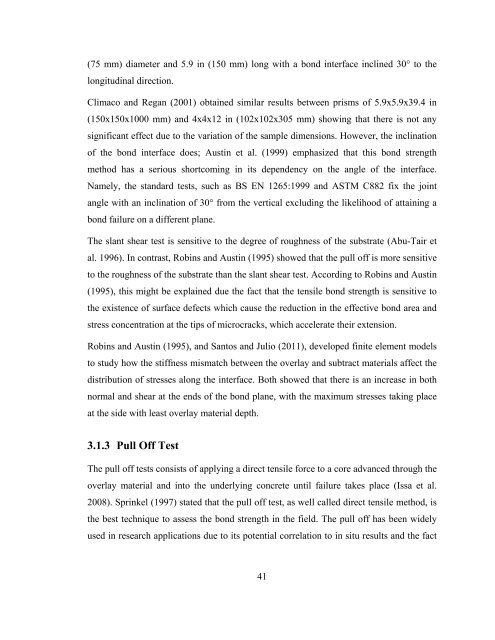compatibility of ultra high performance concrete as repair material
compatibility of ultra high performance concrete as repair material
compatibility of ultra high performance concrete as repair material
You also want an ePaper? Increase the reach of your titles
YUMPU automatically turns print PDFs into web optimized ePapers that Google loves.
(75 mm) diameter and 5.9 in (150 mm) long with a bond interface inclined 30° to thelongitudinal direction.Climaco and Regan (2001) obtained similar results between prisms <strong>of</strong> 5.9x5.9x39.4 in(150x150x1000 mm) and 4x4x12 in (102x102x305 mm) showing that there is not anysignificant effect due to the variation <strong>of</strong> the sample dimensions. However, the inclination<strong>of</strong> the bond interface does; Austin et al. (1999) emph<strong>as</strong>ized that this bond strengthmethod h<strong>as</strong> a serious shortcoming in its dependency on the angle <strong>of</strong> the interface.Namely, the standard tests, such <strong>as</strong> BS EN 1265:1999 and ASTM C882 fix the jointangle with an inclination <strong>of</strong> 30° from the vertical excluding the likelihood <strong>of</strong> attaining abond failure on a different plane.The slant shear test is sensitive to the degree <strong>of</strong> roughness <strong>of</strong> the substrate (Abu-Tair etal. 1996). In contr<strong>as</strong>t, Robins and Austin (1995) showed that the pull <strong>of</strong>f is more sensitiveto the roughness <strong>of</strong> the substrate than the slant shear test. According to Robins and Austin(1995), this might be explained due the fact that the tensile bond strength is sensitive tothe existence <strong>of</strong> surface defects which cause the reduction in the effective bond area andstress concentration at the tips <strong>of</strong> microcracks, which accelerate their extension.Robins and Austin (1995), and Santos and Julio (2011), developed finite element modelsto study how the stiffness mismatch between the overlay and subtract <strong>material</strong>s affect thedistribution <strong>of</strong> stresses along the interface. Both showed that there is an incre<strong>as</strong>e in bothnormal and shear at the ends <strong>of</strong> the bond plane, with the maximum stresses taking placeat the side with le<strong>as</strong>t overlay <strong>material</strong> depth.3.1.3 Pull Off TestThe pull <strong>of</strong>f tests consists <strong>of</strong> applying a direct tensile force to a core advanced through theoverlay <strong>material</strong> and into the underlying <strong>concrete</strong> until failure takes place (Issa et al.2008). Sprinkel (1997) stated that the pull <strong>of</strong>f test, <strong>as</strong> well called direct tensile method, isthe best technique to <strong>as</strong>sess the bond strength in the field. The pull <strong>of</strong>f h<strong>as</strong> been widelyused in research applications due to its potential correlation to in situ results and the fact41
















